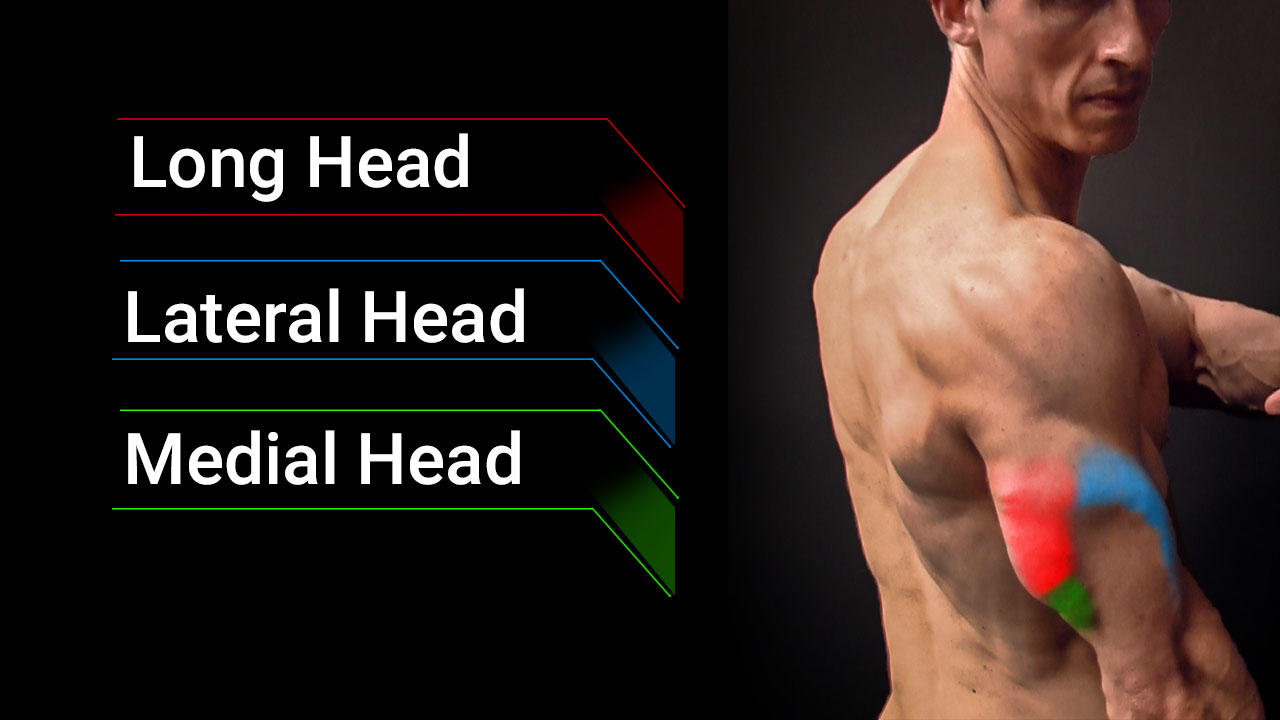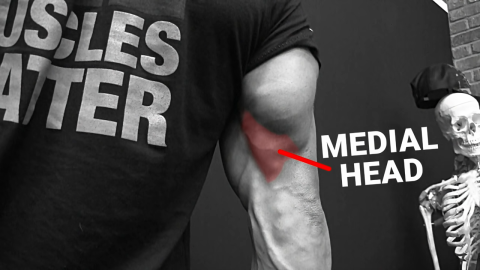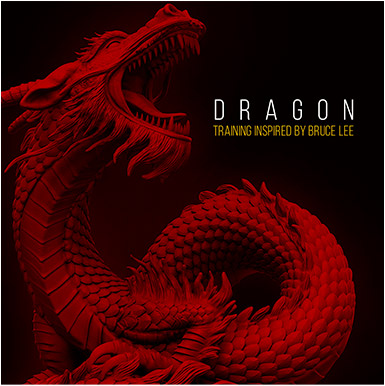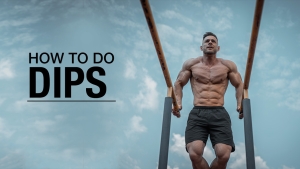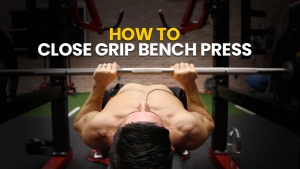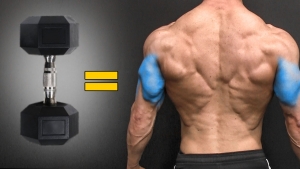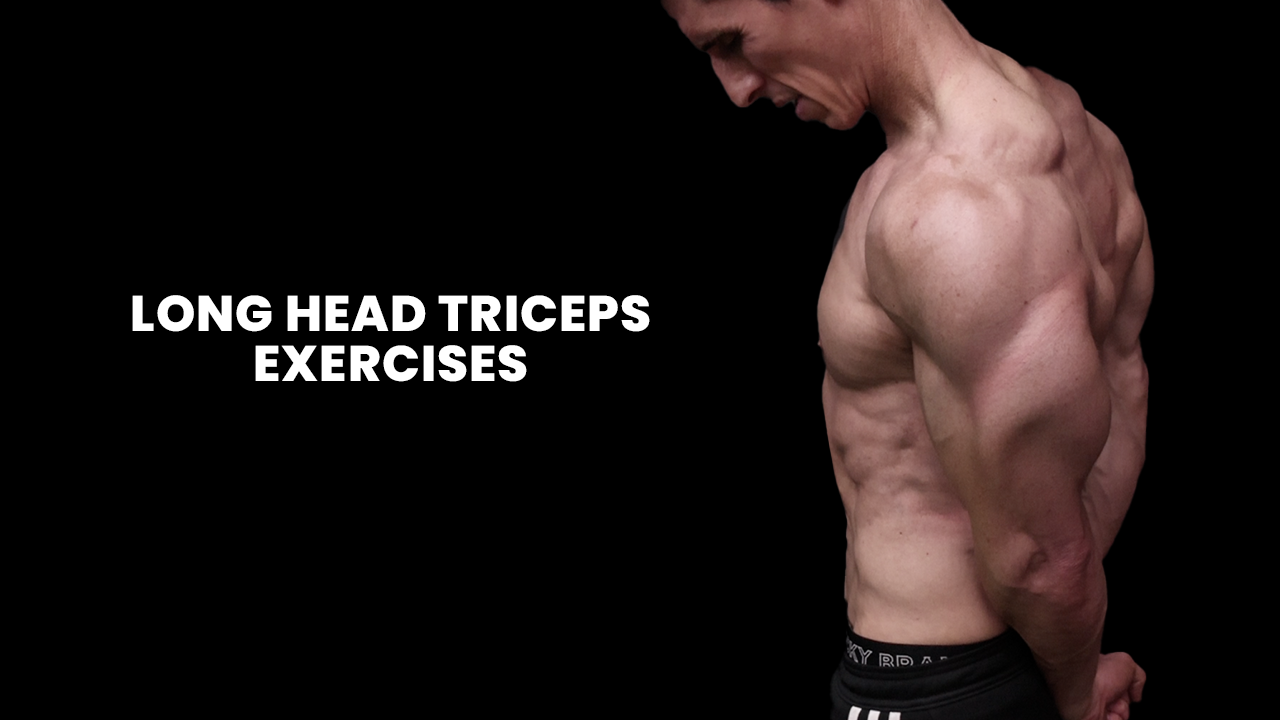
THE KEY TO BIGGER ARMS
Guys, I want to help you fill up those shirt sleeves.
And no, I’m not talking about building bigger biceps.
If you want those sleeves to go from loose to tight, you need to focus on that horseshoe shape on the back of the upper arm.
I’m talking, of course, about the triceps muscle.
The triceps make up two-thirds of the size of your arm so the bigger your triceps, the bigger your arm muscles.
But not all muscle heads of the triceps are created equal.
If you really want to go for serious arm size, you’ll need to focus on long head tricep exercises.
Let’s review the anatomy of the triceps so you can understand where your focus is going to be.
I’ll also cover how to target the tricep with exercises that support growth and development.
ANATOMY OF THE TRICEPS
If you’re like most guys, you know where the triceps muscle is, but you have no idea where the long head of the muscle is located.
We’re going to fix that so you can build a better mind-to-muscle connection.
The better the tricep muscle contracts, the better your results are going to be.
The triceps brachii muscle, with its unique diamond shape, consists of three heads or sections:
- Long heads
- Medial heads
- Lateral heads
Let’s take a closer look at each one:
LONG HEAD
The long head is the larger tricep head of the muscle. It starts from a point on your shoulder joint, just below where the arm connects to the shoulder.
This is different from the other parts of the triceps because it connects to the shoulder blade instead of the upper arm bone.
It then stretches down the back of your arm and joins the other parts of the triceps at the elbow, specifically attaching to the olecranon, which is the pointy part of your elbow bone.
The long head is important for straightening your arm at the elbow. It also plays a role in shoulder extension and other arm movements, like when you bring your arm back or towards your body.
You’ll see that this is important to know when deciding on the best type of exercises for the long head.
But this muscle is not just about movement; it’s also crucial for the shape and size of your upper arm.
As I mentioned above, these are the tricep muscle heads you want to focus on for that fuller, more muscular look from the back.
MEDIAL HEAD
The medial head of the triceps is a key part of the muscle group but it’s also the one that doesn’t get much attention.
Targeted in the right way, the medial head can make a huge difference in your arm size.
It starts from the back of your upper arm bone in an area just below a groove where the nerves and blood vessels run.
It then travels down to join at the elbow, specifically attaching to a point on one of the forearm bones, the ulna. This is the bony part you can feel at the back of your elbow.
The medial head plays a role in straightening your arm at the elbow, making it essential for movements like pushing doors open or doing a push-up.
It’s also important for keeping your elbow stable during precise movements, such as when you’re writing.
While it may not be as visible as other parts of the triceps, the medial head is crucial for both strength and stability in your arm.
LATERAL HEAD
The lateral head starts from the outer tricep, upper portion of your upper arm bone. It’s located on the side of the arm and attaches higher up compared to the other triceps heads.
From there, it stretches down and joins together with the other triceps heads at the pointy part of your elbow bone.
The main job of the lateral head is to help straighten your arm at the elbow, helping with movements like pushing or throwing.
It’s also the part of the triceps that contributes to the defined, muscular appearance of your upper arm, especially when viewed from the side.
LONG HEAD TRICEP EXERCISES
Before we jump into the best long head tricep exercises, I want to break down the specific type of exercises you should be doing.
Many people believe that to effectively work out the long head of the triceps, you need to perform exercises with your arms overhead.
This idea comes from the fact that the long head is unique in its connection to the shoulder, unlike the other parts of the triceps.


When you raise your arm overhead, it stretches the long head more than the other parts, making exercises in this position seem ideal for targeting it.
However, this is only part of the story.
To fully engage the long head of the triceps, you need to move your arm through its entire range of motion.
This means not only lifting your arm overhead but also moving it down and back, behind your body.
If your goal is to really focus on the long head of the triceps, you should include two types of exercises in your routine:
One with your arm overhead to stretch the muscle.
And another that involves moving your arm down and back to fully shorten or contract it.
That means, if you want to target the long head of triceps, you won’t be doing exercises like the close-grip bench press, diamond push-up, or other bench press variations.
Don’t get me wrong – there’s a time and place for close-grip bench presses, but not during long head tricep workout sessions.
As far as rep ranges are concerned, focus on 8-12 reps for the exercises that allow you to use heavier weights. For exercises that require light weight or moderate weights, like tricep kickbacks, aim for 12-15 repetitions.
As always, prioritize the proper form over the number of reps. Rest after you complete your 8-12 reps and move into the next set.
Here’s my go-to list of long head tricep exercises for well-built triceps, starting with overhead exercise movements:
LYING TRICEPS EXTENSION

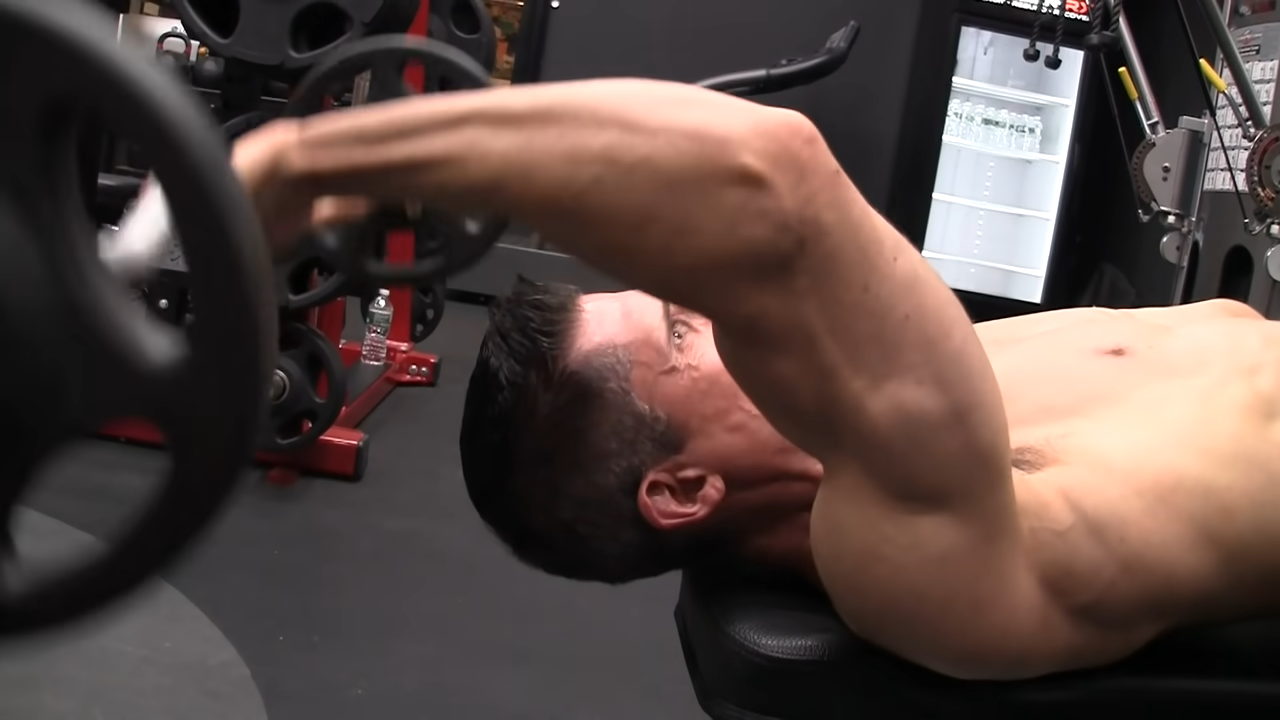
HOW TO DO LYING TRICEPS EXTENSIONS:
- This exercise is also known as skull crushers. Begin by lying on a bench, holding an EZ curl bar above your chest. Ensure your grip is comfortable and secure. Avoid using decline benches for this exercise.
- Instead of holding the bar straight up over your head, angle your arms slightly backward.
- As you lower the bar behind your head, focus on the movement of your upper arms. Let them drop a bit further back toward the bench. This adjustment in form adds intensity to the exercise.
- Press it back to the starting position while maintaining the backward angle of your arms.
WHAT MAKES IT EFFECTIVE: The position of the arms prevents the bar from coming fully straight up over your head, maintaining tension on the triceps.
BANDED LYING TRICEPS EXTENSIONS

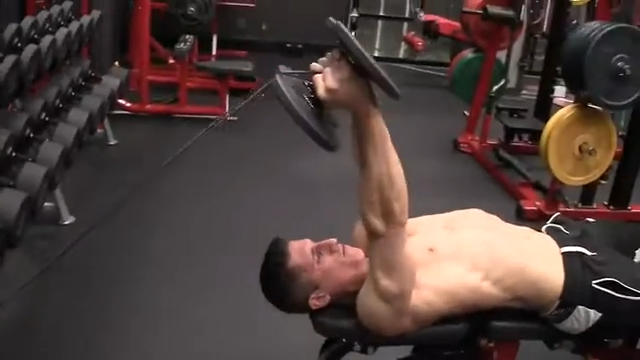
HOW TO DO BANDED LYING TRICEPS EXTENSIONS:
- To perform band tricep extensions, lie on a bench with a pair of dumbbells and resistance bands. Attach one end of each band to the dumbbells and secure the other ends to a stable point behind the bench, such as the base of heavy machines or sturdy fixtures.
- Grasp the dumbbells with a neutral grip (palms facing each other). Begin with the dumbbells above your chest, arms fully extended.
- Instead of allowing the dumbbells to come straight up over your body, keep them angled slightly backward. This position maintains tension on your triceps.
- Lower the dumbbells toward the sides of your head by bending your elbow joints. Keep your upper arms stationary; only your forearms should move.
WHAT MAKES IT EFFECTIVE: As you raise the dumbbells, the bands will stretch, increasing resistance. This added resistance enhances the effectiveness of the exercise, especially at the top of the movement.
PRJ PULLOVER

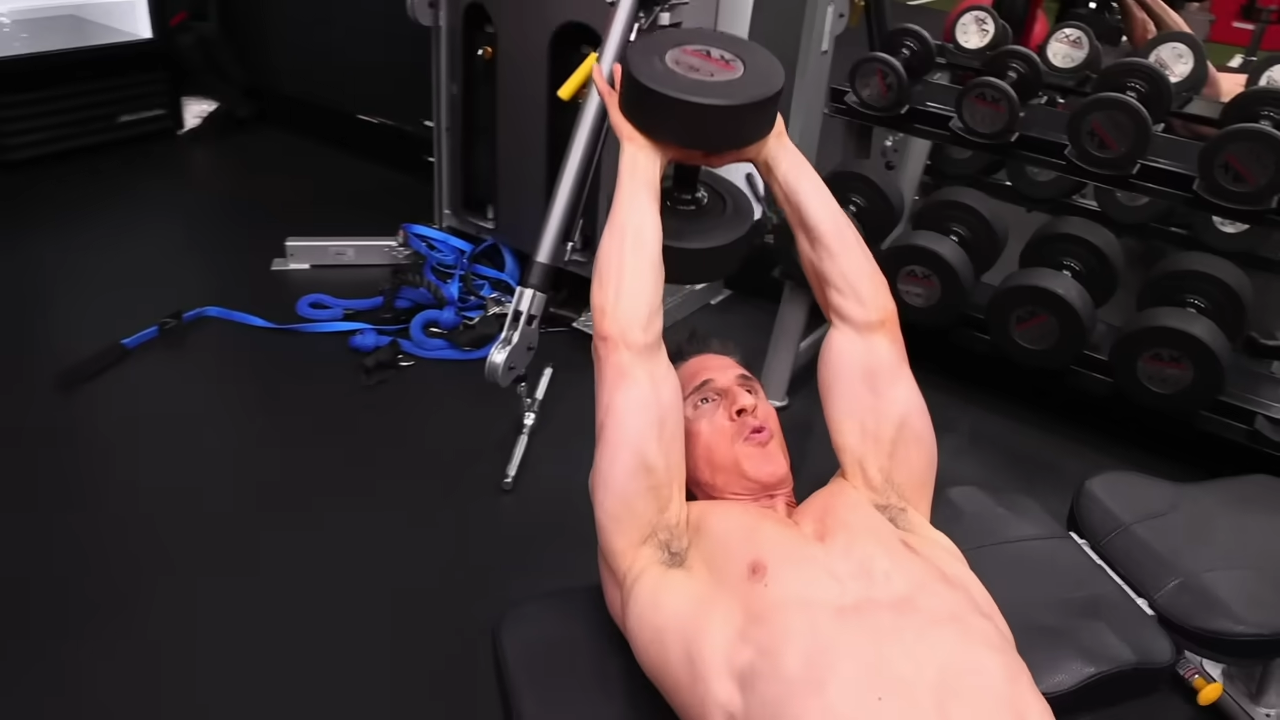
HOW TO DO PRJ PULLOVERS:
- Choose a dumbbell heavier than what you would normally use for a regular triceps extension. This extra weight is manageable because you’ll be using your lats for assistance.
- Lie on your back on a flat bench, holding the dumbbell with both hands above your chest. Your arms should be fully extended.
- Slowly lower the dumbbell back over your head. As you do this, focus on feeling a stretch in both your lats and the tricep long head.
- Once the dumbbell is lowered and you’re at the bottom of the movement, prepare to drive it back up. Instead of solely using your elbows, engage your lats as well.
- Maintain high tension throughout the movement, especially focusing on the triceps.
WHAT MAKES IT EFFECTIVE: The heavy weights combined with the assistance of your lats provides a unique and effective triceps workout.
OVERHEAD CABLE TRICEPS EXTENSIONS

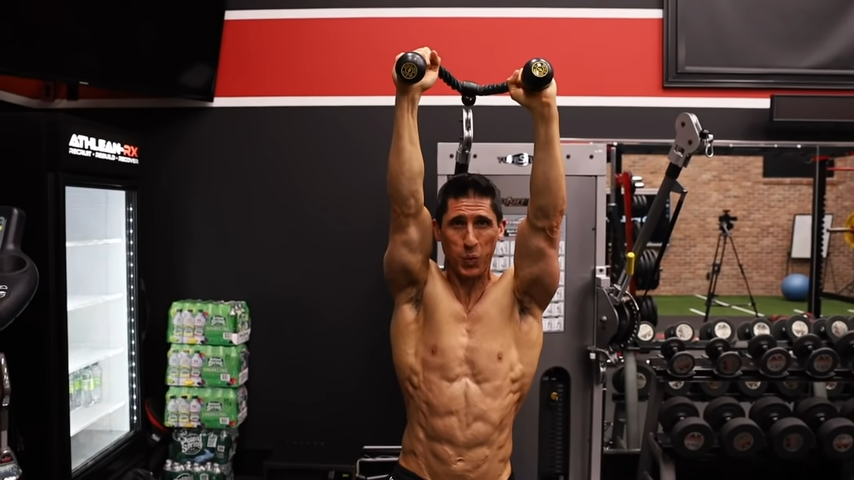
HOW TO THE OVERHEAD CABLE TRICEPS EXTENSION:
- To perform cable overhead rope extensions, set the cable pulley above your head and attach a rope handle.
- Grasp the rope with both hands using a shoulder-width grip, palms facing each other.
- Step away from the cable machine. Position one foot forward to create a stable stance.
- Unlike typical triceps exercises where you hinge forward, maintain a more upright posture. This position puts a greater stretch on the triceps muscles.
- Push the cable handles upward while keeping your posture upright. Your hands should extend in front of your head but avoid overextending.
- Focus on using your triceps to perform the overhead rope tricep extension, keeping the movement controlled and steady.
WHAT MAKES IT EFFECTIVE: When performing cable overhead triceps extensions, standing more upright and aiming to lift your arms high on each repetition enhances your chances of effectively bringing the tricep muscles to failure in each set. You can also use a dumbbell to do the overhead dumbbell extension.
WEIGHT PLATE OVERHEAD EXTENSIONS

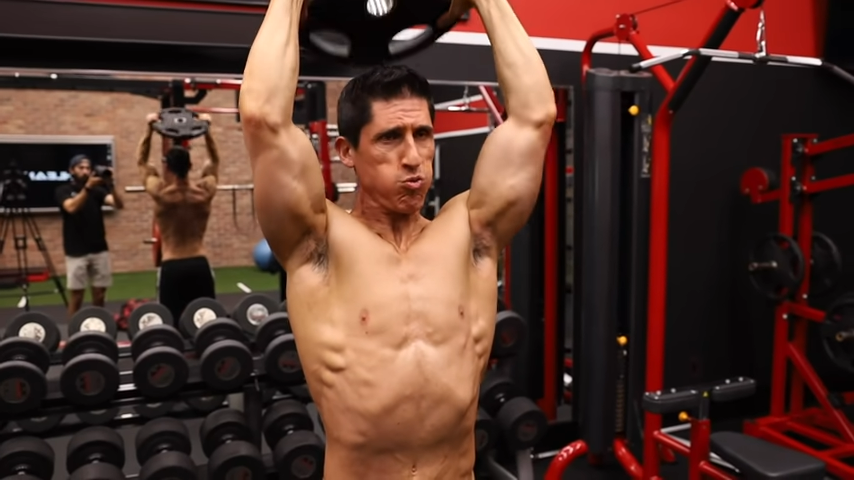
HOW TO DO WEIGHT PLATE OVERHEAD EXTENSIONS:
- Grip the weight plate with both hands, positioning your elbows at a 45-degree angle. This angle is crucial for targeting the triceps effectively.
- Begin by pushing the weight plate overhead, keeping your elbows forward, not out to the sides.
- Ensure that your upper arms remain stationary; only your forearms should be moving.
- Slowly lower the weight plate behind your head. You’ll notice that you can go much further back than with traditional dumbbell extensions, allowing for a fuller stretch in the triceps.
- Reverse the motion by pushing the weight plate back overhead. The focus should be on engaging the triceps to lift the plate.
WHAT MAKES IT EFFECTIVE: This exercise targets the long head of the triceps effectively through an overhead arm posture, and using a weight plate allows for a greater stretch since its narrow shape enables a fuller range of motion compared to a dumbbell.
CABLE PUSHAWAY

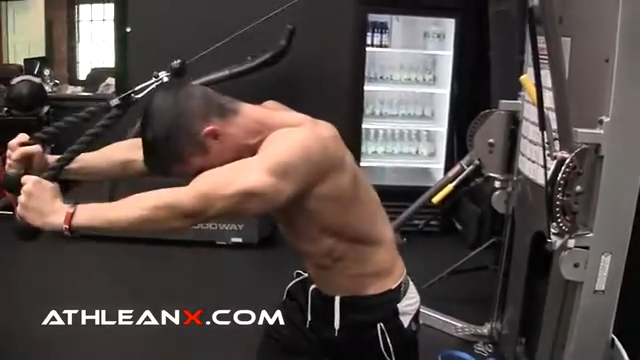
HOW TO DO THE CABLE PUSHAWAY:
- Start by setting up a cable machine with a rope attachment. Adjust the pulley to the high position.
- Grasp the rope with both hands, palms facing each other.
- Stand facing away from the cable machine and move into a staggered stance. Lean forward slightly at your hips while keeping your back straight.
- Raise your arms overhead with elbows bent and the rope behind your head.
- Extend your arms fully, pushing the rope forward. Focus on using your triceps to perform the extension.
- Keep your upper arms close to your head and stationary throughout the exercise. Only your forearms should move.
- At the top of the movement, when your arms are fully extended, pause briefly to contract your triceps.
- Slowly return to the starting position with your elbows bent and the rope behind your head.
WHAT MAKES IT EFFECTIVE: The constant tension of the cables and the extra stretch on the long head makes this an excellent triceps exercise to add to your workout.
TRICEPS KICKBACKS

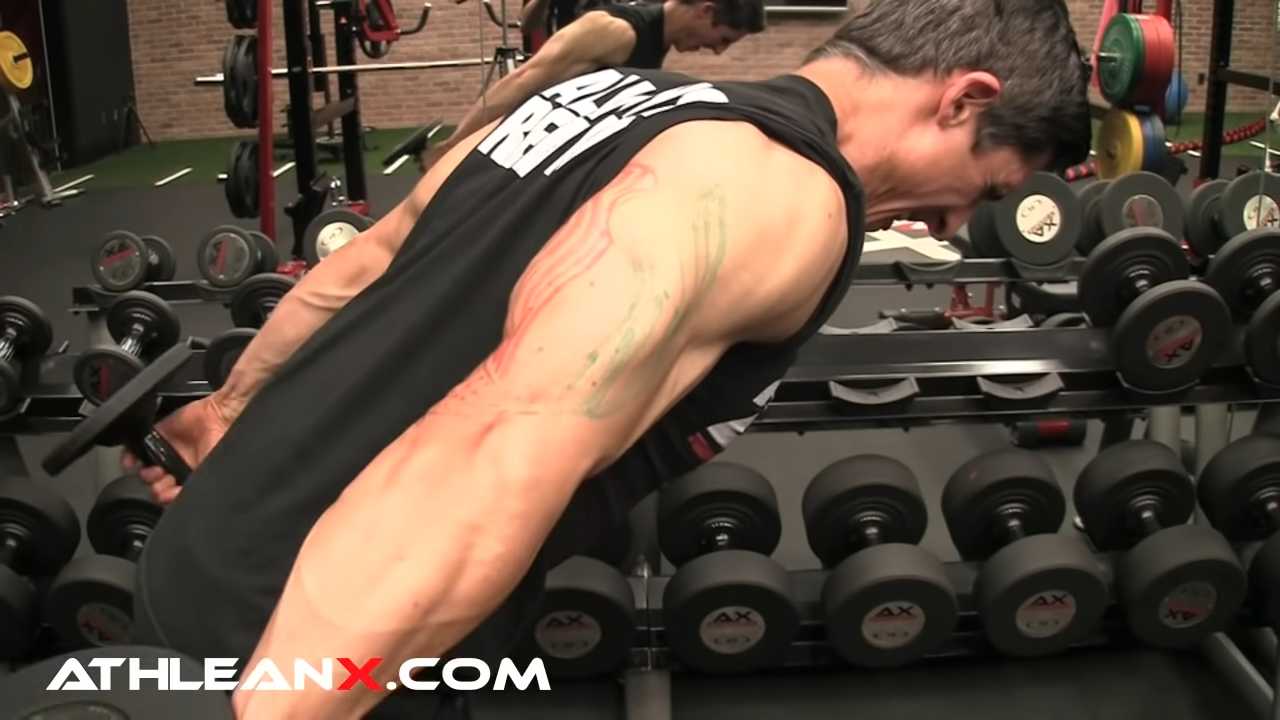
HOW TO DO THE TRICEPS KICKBACK:
- Choose a pair of lighter dumbbells. You’ll be focusing on intensity and contraction.
- Stand with your feet shoulder-width apart. Hold a dumbbell in each hand with an overhand grip.
- Bend forward at your hips, keeping a neutral spine position. Keep your upper body nearly horizontal to the ground. Keep your head in a neutral position, aligned with your spine.
- Bend your elbows so your upper arms are aligned with your torso. Your forearms should be perpendicular to the floor. This is your starting position.
- Extend your arms backward by straightening your elbows. Your upper arms should remain stationary; only your forearms should move. Fully extend your arms, focusing on contracting your triceps.
- At the top of the movement, when your arms are fully extended, squeeze your triceps for a moment to maximize contraction.
- Slowly return to the starting position by bending your elbows. Keep the movement controlled, maintaining tension in your triceps.
WHAT MAKES IT EFFECTIVE: The classic tricep kickback allows you to get your arms behind your body and move the long head through its full range of motion.
DRAG PUSHDOWN

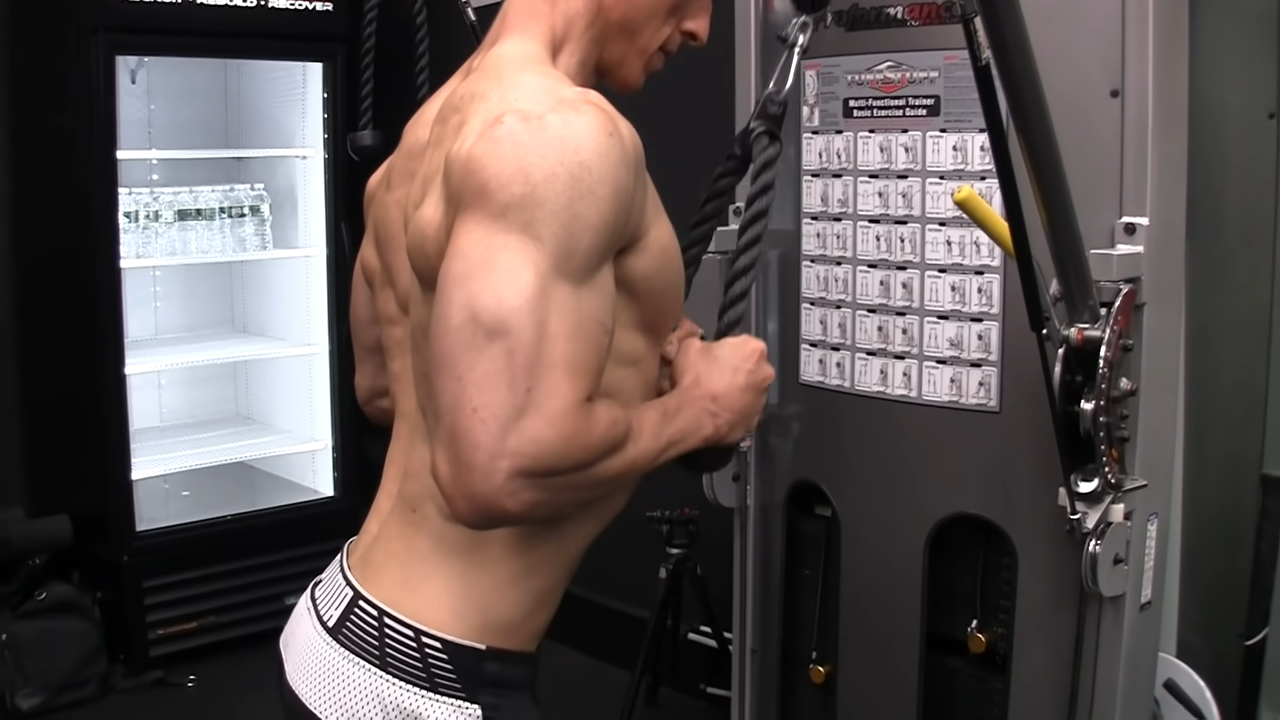
HOW TO DO THE DRAG PUSHDOWN:
- Stand in front of a cable machine with a straight bar or rope attachment set at a high pulley. Use a narrower grip on the bar with your hands less than shoulder-width apart.
- Position your elbows close to your body and as far back as possible. This position should be maintained throughout the exercise to focus on the triceps, especially the long head.
- Begin the pushdown by pulling the bar or rope down towards your thighs. Keep the bar as close to your body as possible, literally dragging it down the front of your torso.
- Squeeze the triceps at the bottom of the movement then slowly return to the starting position.
WHAT MAKES IT EFFECTIVE: By ensuring that your elbows remain stationary and far back, you’ll be able to move your triceps into full extension.
SINGLE-ARM CABLE TRICEPS PUSHDOWN

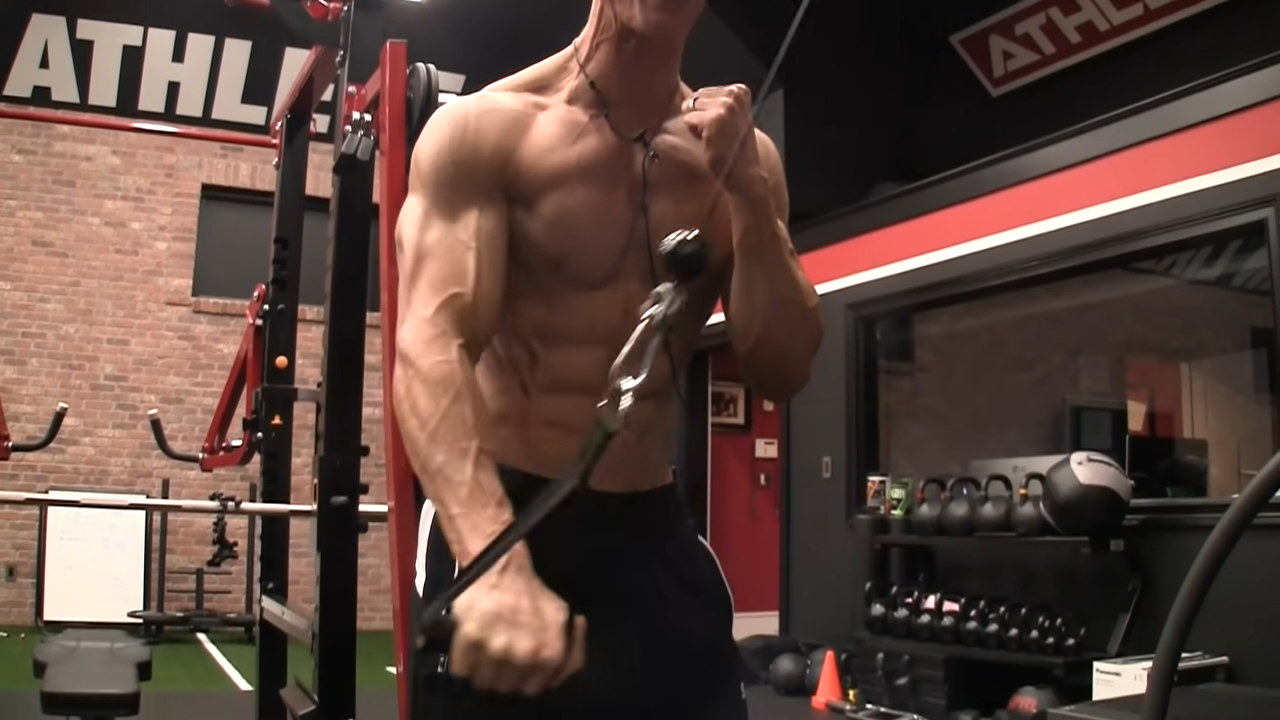
HOW TO DO SINGLE-ARM TRICEPS PUSHDOWNS:
- Adjust the cable machine pulley to a height above your head.
- Stand with your feet in a staggered stance for stability.
- Instead of the usual straight grip, use an offset grip on the rope attachment. This means you’ll be pulling the rope to one side at a time.
- Contract your triceps muscle and push down the rope with one arm. Aim to get a strong contraction in the triceps and hold this position momentarily.
- Slowly return to the starting position with control, maintaining the focus on your triceps.
- After finishing with one arm, be sure to switch and perform the exercise with the other arm.
WHAT MAKES IT EFFECTIVE: This is an exceptionally effective exercise because utilizing an offset grip allows for greater arm extension behind the body, resulting in a more intense contraction.
TRICEP TRUNK LIFT

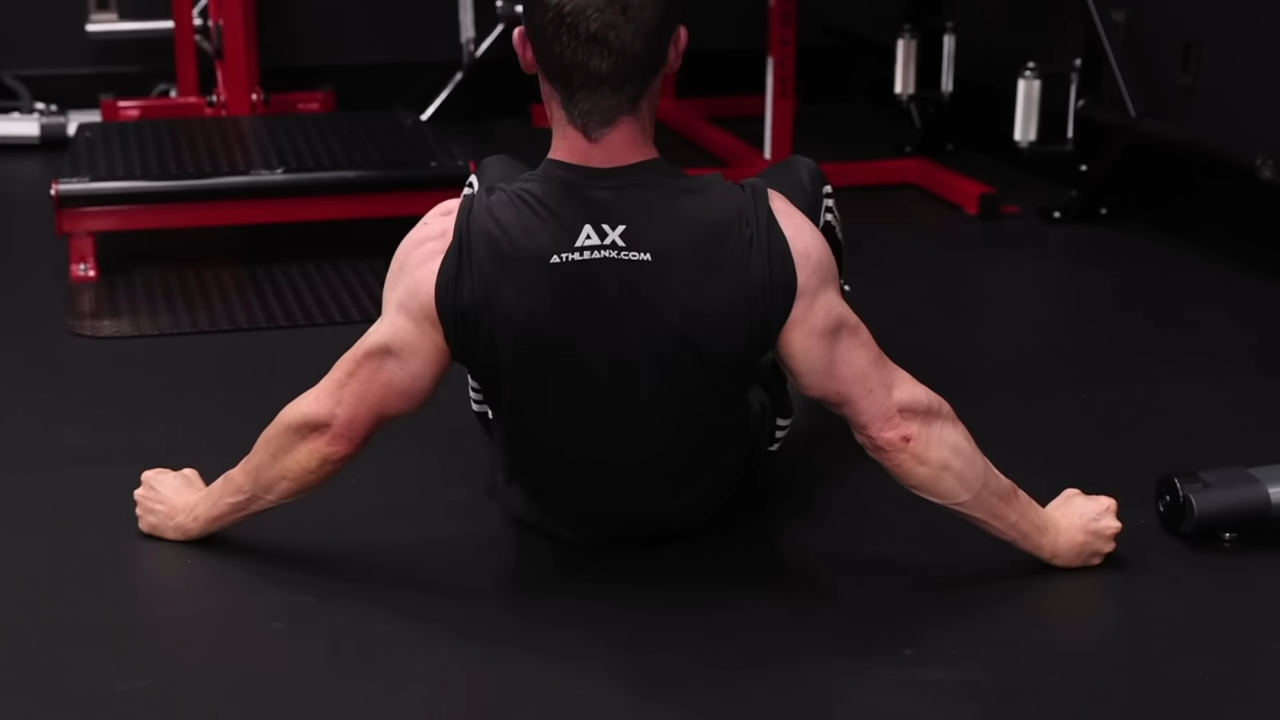
HOW TO DO THE TRICEPS TRUNK LIFT:
- You’ll be using your body weight for this exercise so begin by lying down on the ground. Bend your knees to help support your lower body. Keep your feet flat on the floor.
- Make fists with both hands.
- Place your elbows on the ground close to your sides. Your forearms should be perpendicular to the floor.
- Press your fists and elbows into the floor to lift your upper body off the ground. This movement should primarily engage your triceps.
- As you lift yourself, focus on extending your elbows and pressing your arms back behind your body.
- Lower yourself back down to the ground slowly and in a controlled manner.
WHAT MAKES IT EFFECTIVE: One of my favorite bodyweight exercises, this dual action – elbow extension and arm extension – intensively activates the long head of the triceps.
DUMBBELL OVERHEAD EXTENSION TO KICKBACKS

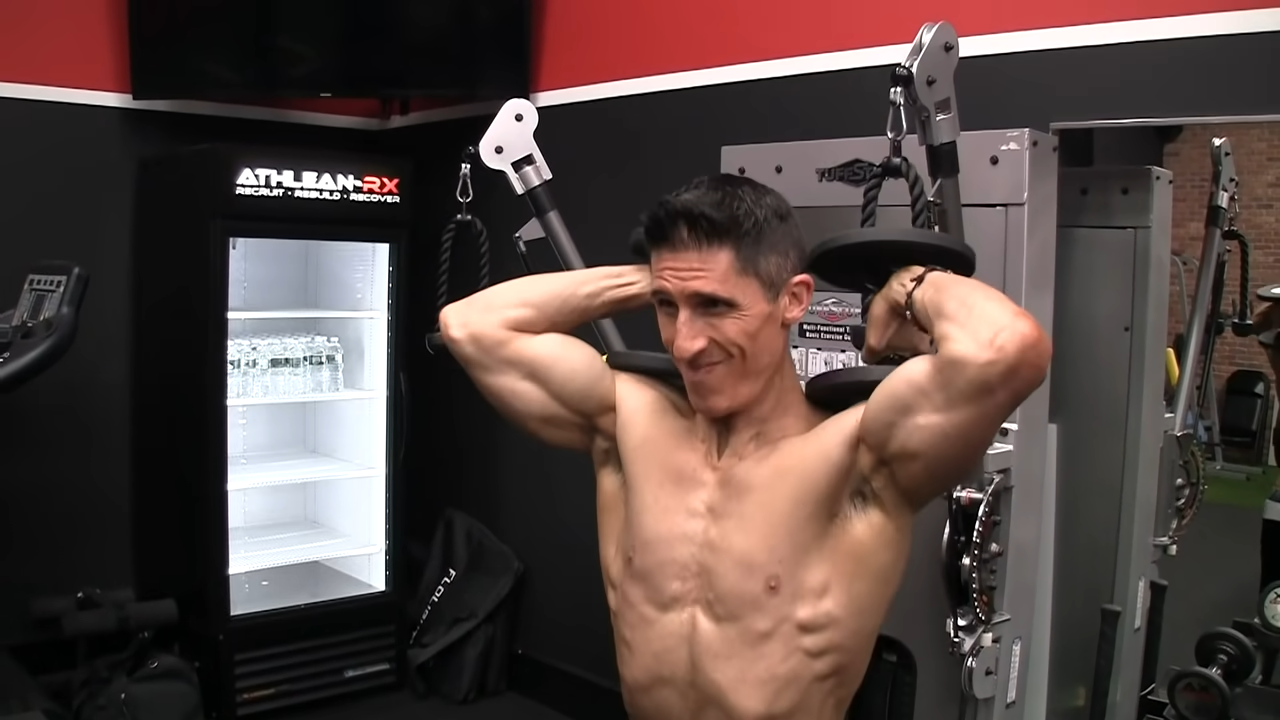
HOW TO DO DUMBBELL OVERHEAD EXTENSION TO KICKBACKS:
- Stand upright holding a dumbbell in each hand. Raise the dumbbells above your head for the overhead triceps extension part of the exercise.
- Keep your elbows in front of your body rather than flaring them out to the sides. This position is safer for your shoulders and allows for more effective targeting of the triceps.
- Extend your arms upward, fully stretching your triceps. Then, bend your elbows to lower the dumbbells behind your head to a 90-degree angle. Keep your upper arms stationary; only your forearms should move.
- After completing the overhead extension, bend forward at your hips while maintaining a straight back. Transition smoothly into the dumbbell kickback part of the exercise.
- With your torso bent forward, keep your upper arms close to your sides. Extend your arms back, focusing on using your triceps to perform the movement. Your forearms should move, while your upper arms remain stationary.
- If the weight you can handle for kickbacks is significantly less than what you can manage for overhead extensions, adjust the reps accordingly. For every rep of a kickback, do two or three reps of the overhead extension.
WHAT MAKES IT EFFECTIVE: This is an excellent combination exercise if you’re short on time but still looking to take the long head through its full range of motion for optimal results.
MAXIMIZING TRICEPS MUSCLE GROWTH
Maximum growth in the triceps, particularly the long head, requires a multifaceted approach.
Incorporating a variety of exercises, focusing on perfect form and time under tension, and ensuring adequate rest and recovery are key to unlocking your muscle growth potential.
Here are some tips and tricks for optimizing hypertrophy to reach your goals:
PICKING THE RIGHT EQUIPMENT
The right machines and equipment matter, but so does variety.
Be sure to change the equipment you use. You don’t have to stick to just one thing.
Utilizing a variety of equipment like the pulley machine, weight machines, dip stations, and resistance bands can help to support a full range of motion and contraction for muscular growth.
Don’t forget to mix up the stimulus by also using different handles such as the rope pushdowns handle or single handle.
Switching between the lying triceps extension with an EZ curl bar and the banded dumbbell lying triceps extension is a great example of this.
REPETITION RANGE
Depending on the exercise and where you are in your workout, you’ll want to cycle through different rep ranges.
- If you’re using heavier weights, aim for 8-12 reps.
- If you’re lifting moderate weight, use 10-12 reps.
- If you’re pushing light weight, you can perform 12-15 reps.
All have a place when your goal is muscular hypertrophy. You’ll also want to focus on the right amount of tension.
TIME UNDER TENSION
Maintaining constant tension on the triceps, especially in the stretched position, is essential for maximizing growth potential.
Exercises like triceps kickbacks and overhead tricep extensions, performed with a lighter weight for more reps, can ensure that the muscle is under tension throughout the movement.
You can also add resistance bands to some effective triceps exercises to include variable resistance and consistent tension to the exercise.
DROP SETS
Drop sets are a powerful method for targeting the tricep long head, key for achieving a longer time under tension and building tricep muscle mass.
Begin with effective compound movements like close-grip bench presses or dips, ensuring a stable body position and controlled movement. Keep your body upright and elbows close to minimize elbow flare.
Shift to isolation movements, such as tricep kickbacks or overhead extensions, focusing on keeping the elbow stationary and your body straight or slightly bent.
These exercises isolate the tricep long head, emphasizing movement at the elbow joint.
In drop sets, start with heavier weights or challenging bodyweight movements, then immediately switch to lighter weights or easier variations, like from weighted to bodyweight dips.
This technique ensures thorough muscle fiber engagement for growth.
Use the lowest setting or lightest weights initially, progressively increasing intensity.
This combination of compound and isolation movements, coupled with controlled, stable movements, significantly enhances tricep long head development.
INTEGRATING COMPOUND MOVEMENTS
As mentioned above, incorporating compound movements like the barbell bench press into your routine can provide a superior stimulus for the triceps.
Controlled movements that involve multiple joints and muscle groups can lead to more significant muscle growth and strength gains.
BODYWEIGHT EXERCISES AND VARIATIONS
Effective bodyweight exercises like tricep dips, diamond push-ups, and tricep trunk lifts can be modified for increased difficulty, such as using a dip belt or performing them at a 30 to 45-degree angle.
Overhead tricep extension variations and suspended push-ups also provide a nice stimulus to the long head triceps, promoting tricep development.
REST AND RECOVERY
Rest days are critical for muscle recovery and growth in your weekly plan. A balance of 2-3 days’ rest between workouts, combined with adequate sleep and nutrition, ensures the triceps have enough time to recover and grow.
Including dynamic stretching and maintaining shoulder mobility can further enhance the effectiveness of your arm workouts.
Remember, consistency and dedication to your routine will ultimately lead to a larger, more defined, and stronger triceps brachii muscle.
Your triceps, specifically the long head of the triceps, are your key to building huge and well-developed arms.
Remember: The quality of the exercises you choose matters for effective tricep training.
Focus on the exercises above, which move your arm overhead or down and back behind your body, ensuring the long head is taken through a larger range of motion.
And be sure to do your compound movements first then move to isolation exercises.
Are you looking for more than a tricep workout – maybe a complete workout program? We’ve got you covered! Check out our ATHLEAN-X programs to see which is the best fit for your goals and fitness level.

- The triceps muscle makes up two-thirds of the arm’s size, significantly influencing how large and developed the arm looks overall.
- There are three triceps heads or sections: long heads, medial heads, and lateral heads.
- The long head of the triceps, distinct in its shoulder blade attachment and crucial for both arm straightening and certain shoulder movements, is the largest tricep head muscle.
- It plays a key role in both arm movement and contributing to the upper arm’s muscular appearance.
- An effective workout of the triceps long head involves more than just overhead arm exercises; it requires a full range of motion, including both overhead movements for stretching and down-and-back movements to achieve full tricep activation.
- Overhead triceps exercises consist of the lying triceps extension, overhead cable triceps extension, and cable pushaway.
- Exercises involving moving your arm down and back include tricep dumbbell kickbacks, drag tricep pushdowns, and tricep trunk lifts.
- Other exercises for building triceps include cable triceps pushdowns, triangle shape push-ups, and close grip bench presses, but these do not isolate the long head of the triceps muscle.
LONG HEAD TRICEPS EXERCISES FAQS
There are two types of tricep exercises that are ideal for targeting the long head of the muscle:
One variation involves extending your arm overhead to stretch the muscle, and another requires moving your arm downward and backward to fully shorten and contract it.
Exercises that are performed overhead include the lying triceps extension, overhead cable triceps extension, and cable pushaway.
Tricep exercises that move your arm down and back include triceps kickbacks, drag pushdowns, and tricep trunk lifts.
Yes, tricep dips do hit the long head of the triceps muscle, but this exercise is equally effective for targeting the lateral and medial heads as well.
If you want to specifically target the long head of the triceps, I’d recommend focusing on two types of exercises: those that move your arm overhead and those that move your arm down and back.
Examples of long head triceps exercises include banded lying triceps extensions, weight plate overhead extensions, and single-arm triceps pushdowns.
To isolate the long head of the triceps, focus on these two types of exercises:
Exercises with Arm Overhead: These exercises stretch the long head of the triceps by placing your arms in an overhead position. When the arm is overhead, the long head is elongated, which allows it to be targeted more effectively. I’d recommend the lying triceps extension, PRJ pullover, and overhead cable triceps extension.
Exercises Moving Arm Down and Back: These exercises focus on moving the arm down and back, which also effectively engages the long head of the triceps. This movement pattern involves both the muscle in elbow extension and a degree of shoulder extension or adduction. I’d recommend performing triceps kickbacks and drag pushdowns.
The best long head of tricep workout will be a combination of exercises that accomplish two things: moving the arm overhead and moving the arm down and back behind the body.
My favorite exercises that go overhead include lying triceps extensions and cable pushaway.
Exercises that go down and back behind the body include the tricep trunk lift and single-arm triceps pushdown.
As for full triceps training, I’d recommend performing a compound exercise first like the barbell bench press followed by these isolation exercises.
To train the long head of the triceps effectively, focus on exercises that involve moving your arms overhead, which stretches the long head, and exercises that require moving your arm down and back. These movements are key for specifically targeting and activating the long head of the triceps.
REFERENCES

Jeff Cavaliere M.S.P.T, CSCS
Jeff Cavaliere is a Physical Therapist, Strength Coach and creator of the ATHLEAN-X Training Programs and ATHLEAN-Rx Supplements. He has a Masters in Physical Therapy (MSPT) and has worked as Head Physical Therapist for the New York Mets, as well as training many elite professional athletes in Major League Baseball, NFL, MMA and professional wrestling. His programs produce “next level” achievements in muscle size, strength and performance for professional athletes and anyone looking to build a muscular athletic physique.
















